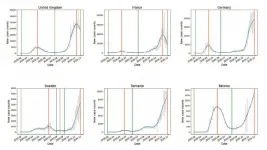(Press-News.org) URBANA, Ill. - Corn didn't start out as the powerhouse crop it is today. No, for most of the thousands of years it was undergoing domestication and improvement, corn grew humbly within the limits of what the environment and smallholder farmers could provide.
For its fertilizer needs, early corn made friends with nitrogen-fixing soil microbes by leaking an enticing sugary cocktail from its roots. The genetic recipe for this cocktail was handed down from parent to offspring to ensure just the right microbes came out to play.
But then the Green Revolution changed everything. Breeding tools improved dramatically, leading to faster-growing, higher-yielding hybrids than the world had ever seen. And synthetic fertilizer application became de rigueur.
That's the moment corn left its old microbe friends behind, according to new research from the University of Illinois. And it hasn't gone back.
"Increasing selection for aboveground traits, in a soil setting where we removed all reliance on microbial functions, degraded microbial sustainability traits. In other words, over the course of half a century, corn breeding altered its microbiome in unsustainable ways," says Angela Kent, professor in the Department of Natural Resources and Environmental Sciences at the University of Illinois and co-author of a new study in the International Society of Microbial Ecology Journal.
Kent, along with co-authors Alonso Favela and Martin Bohn, found modern corn varieties recruit fewer "good" microbes - the ones that fix nitrogen in the soil and make it available for crops to take up - than earlier varieties. Instead, throughout the last several decades of crop improvement, corn has been increasingly recruiting "bad" microbes. These are the ones that help synthetic nitrogen fertilizers and other sources of nitrogen escape the soil, either as potent greenhouse gases or in water-soluble forms that eventually end up in the Gulf of Mexico and contribute to oxygen-starved "dead zones."
"When I was first analyzing our results, I got a little disheartened," says Favela, a doctoral student in the Program in Ecology, Evolution, and Conservation Biology at Illinois and first author on the study. "I was kind of sad we had such a huge effect on this plant and the whole ecosystem, and we had no idea we were even doing it. We disrupted the very root of the plant."
To figure out how the corn microbiome has changed, Favela recreated the history of corn breeding from 1949 to 1986 by planting a chronological sequence of 20 off-patent maize lines in a greenhouse.
"We have access to expired patent-protected lines that were created during different time periods and environmental conditions. We used that understanding to travel back in time and look at how the associated microbiome was changing chronologically," he says.
As a source of microbes, Favela inoculated the pots with soil from a local ag field that hadn't been planted with corn or soybeans for at least two years. Once the plants were 36 days old, he sequenced the microbial DNA he collected from soil adhering to the roots.
"We characterized the microbiome and microbial functional genes related to transformations that occur in the nitrogen cycle: nitrogen fixation, nitrification, and denitrification," he says. "We found more recently developed maize lines recruited fewer microbial groups capable of sustainable nitrogen provisioning and more microbes that contribute to nitrogen losses."
Kent says breeding focused on aboveground traits, especially in a soil context flooded with synthetic nitrogen fertilizers, may have tweaked the sugary cocktail roots exude to attract microbes.
"Through that time period, breeders weren't selecting for maintenance of microbial functions like nitrogen fixation and nitrogen mineralization because we had replaced all those functions with agronomic management. As we started selecting for aboveground features like yield and other traits, we were inadvertently selecting against microbial sustainability and even actively selecting for unsustainable microbiome features such as nitrification and denitrification," she says.
Now that it's clear something has changed, can breeders bring good microbes back in corn hybrids of the future?
Bohn, corn breeder and associate professor in the Department of Crop Sciences at Illinois, thinks it's very possible to "rewild" the corn microbiome. For him, the answer lies in teosinte, a wild grass most people would have to squint pretty hard at to imagine as the parent of modern corn.
Like wild things everywhere, teosinte evolved in the rich context of an entire ecosystem, forming close relationships with other organisms, including soil microbes that made soil nutrients easier for the plant to access. Bohn thinks it should be possible to find teosinte genes responsible for creating the root cocktail that attracts nitrogen-fixing microbes. Then, it's just a matter of introducing those genes into novel corn hybrids.
"I never thought we would go back to teosinte because it's so far removed from what we want in our current agricultural landscape. But it may hold the key not only for encouraging these microbial associations; it also may help corn withstand climate change and other stresses," Bohn says. "We actually need to go back to teosinte and start investigating what we left behind so we can bring back these important functions."
Bringing back the ability for corn to recruit its own nitrogen fixation system would allow producers to apply less nitrogen fertilizer, leading to less nitrogen loss from the system overall.
"Farmers don't always know how much nitrogen they will need, so, historically, they've dumped as much as possible onto the fields. If we bring these characteristics back into corn, it might be easier for them to start rethinking the way they manage nitrogen," Bohn says.
Kent adds that a little change could go a long way.
"If we could reduce nitrogen losses by even 10% across the growing region of the Midwest, that would have huge consequences for the environmental conditions in the Gulf of Mexico," she says.
INFORMATION:
The article, "Maize germplasm chronosequence shows crop breeding history impacts recruitment of the rhizosphere microbiome," is published in the International Journal of Microbial Ecology Journal.
The Department of Natural Resources and Environmental Sciences and the Department of Crop Sciences are in the College of Agricultural, Consumer and Environmental Sciences at the University of Illinois.
Radio telescopes are the world's most sensitive radio receivers, capable of finding extremely faint wisps of radio emission coming from objects at the farthest reaches of the universe. Recently, a team of astronomers used the National Science Foundation's Karl G. Jansky Very Large Array (VLA) to take advantage of a helping hand from nature to detect a distant galaxy that likely is the faintest radio-emitting object yet found.
The discovery was part of the VLA Frontier Fields Legacy Survey, led by NRAO Astronomer Eric Murphy, which used distant clusters of galaxies as natural lenses ...
Recent research shows that people are more likely to take "microbreaks" at work on days when they're tired - but that's not a bad thing. The researchers found microbreaks seem to help tired employees bounce back from their morning fatigue and engage with their work better over the course of the day.
At issue are microbreaks, which are short, voluntary and impromptu respites in the workday. Microbreaks include discretionary activities such as having a snack, chatting with a colleague, stretching or working on a crossword puzzle.
"A microbreak is, by definition, short," says Sophia Cho, co-author of a paper on the work and an assistant professor ...
RESEARCH TRIANGLE PARK, N.C. -- Joint Army- and Air Force-funded researchers have taken a step toward building a fault-tolerant quantum computer, which could provide enhanced data processing capabilities.
Quantum computing has the potential to deliver new computing capabilities for how the Army plans to fight and win in what it calls multi-domain operations. It may also advance materials discovery, artificial intelligence, biochemical engineering and many other disciplines needed for the future military; however, because qubits, the fundamental building blocks of quantum computers, are intrinsically fragile, a longstanding barrier to quantum computing has been effective implementation of quantum error correction.
Researchers at University of Massachusetts Amherst, ...
Corporate strategies should be as unique as possible, in fact highly specific to each individual company. This enables companies to compete successfully in the long term. However, the capital market and others, including analysts, often react negatively to the idea of unique strategies. The reason is that deviating from typical industry standards makes them more complex to evaluate. This regularly discourages companies from focusing on unique strategies, even though they would be beneficial for the company in the long term. This contradiction is known as the "uniqueness paradox". A research team from the Universities of Göttingen and Groningen has investigated the influence of different types of investors on the extent of the paradox and thus on the choice of unique strategies. The results ...
Higher progesterone level is protective in mild traumatic brain injury
Blood flow in brain is linked to progesterone and stress symptom levels
Most concussion research has been focused on male athletes
CHICAGO --- Could birth control pills help young female athletes recover faster from concussions and reduce their symptoms?
A new Northwestern Medicine pilot study has shown when a female athlete has a concussion injury during the phase of her menstrual cycle when progesterone is highest, she feels less stress. Feeling stressed is one symptom of a concussion. Feeling less stressed is a marker of recovery.
The study also revealed for the first time the physiological reason for the neural protection is increased ...
New research from the University of Florida Warrington College of Business finds that feeling psychologically powerful makes leaders' jobs seem more demanding. And perceptions of heightened job demands both help and hurt powerful leaders.
Trevor Foulk of the University of Maryland Robert H. Smith School of Business and Klodiana Lanaj, Martin L. Schaffel Professor at UF, note that while power-induced job demands are key to helping leaders more effectively pursue their goals and feel that their jobs are meaningful each day at work, these demands can also cause pain and discomfort, felt in the evening at home.
"Power is generally considered a desirable thing, as leaders often seek power, and it's very rare for leaders to turn powerful roles down," Foulk said. "However, this view is qualified ...
WASHINGTON, March 16, 2021 -- Sea-based fish farming systems using net pens are hard on the environment and the fish. A closed cage can improve fish welfare, but fresh seawater must be continuously circulated through the cage. However, ocean waves can cause this circulating water to slosh inside the cage, creating violent motions and endangering the cage and the fish.
A study using a scale-model fish containment system is reported in Physics of Fluids, by AIP Publishing. The study shows why violent sloshing motions arise and how to minimize them.
Gentle currents can be artificially maintained inside cylindrical closed cages developed for salmon farming. The current is produced by injecting seawater through ...
WASHINGTON, March 16, 2021 -- As Europe experienced its enormous second wave of the COVID-19 disease, researchers noticed the mortality rate -- progression from cases to deaths -- was much lower than during the first wave.
This inspired researchers from the University of Sydney and Tsinghua University to study and quantify the mortality rate on a country-by-country basis to determine how much the mortality rate from the second wave decreased from the first.
In Chaos, by AIP Publishing, Nick James, Max Menzies, and Peter Radchenko introduce methods to study the progression of COVID-19 cases to deaths during the pandemic's different waves. Their methods involve applied mathematics, specifically nonlinear dynamics, and time series analysis.
"We take a time series, ...
Researchers from the lab of Hans Clevers (Hubrecht Institute) and the UMC Utrecht used organoid technology to grow miniature human tear glands that actually cry. The organoids serve as a model to study how certain cells in the human tear gland produce tears or fail to do so. Scientists everywhere can use the model to identify new treatment options for patients with tear gland disorders, such as dry eye disease. Hopefully in the future, the organoids can even be transplanted into patients with non-functioning tear glands. The results will be published in Cell Stem Cell on the 16th of March.
The tear gland is located in the upper part of the eye socket. It secretes tear fluid, which is essential for lubrication and nutrition of the cornea and has antibacterial components. Rachel Kalmann ...
Like a well-trained soldier, a white blood cell uses specialized abilities to identify and ultimately destroy dangerous intruders, including creating a protrusion to effectively reach out, lock-on, probe, and possibly attack its prey. Researchers reporting March 16 in Biophysical Journal show in detail that these cells take seconds to morph into these highly rigid and viscous defensive units.
Senior author Julien Husson (@_julienhusson), a biophysicist at École Polytechnique near Paris, and collaborators showed previously that certain white blood cells, called T cells, ...


